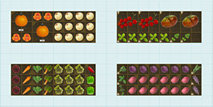How to grow Celeriac / Celery Root?
- Latin Family: Apiaceae
- Latin Genus: Apium
- Ease of Growing: Moderate
- Growing Type: Annual
This is the same species as celery, but is grown for its root (actually a swollen stem base or corm) rather than its stems. It has pretty much the same requirements as celery and is grown in the same way. It is easier to grow though, because you don't really care about the quality of the stems. The main edible part is the root.
Celeriac / Celery Root History
This cool weather biennial is native to Europe. This is a celery that is grown for its delicious root. It is grown in Eastern Europe and is loved by the French in a salad.
Soil Preference
- PH (min/max): 6.0 - 7.0
- PH Ideal (min/max): 6.3 - 6.6
Wild Celery naturally grows near water and this is reflected in its preference for a rich, deep, moist (but not wet), fairly acid soil, with lots of organic matter. It is a hungry crop, requiring a lot of nitrogen, potassium and phosphorus.
How to care for Celeriac / Celery Root?
Celeriac is an upright, compact plant and doesn't take up a lot of space (which is good, as it is in the ground for quite a long time). In cool climates it prefers full sun, but in hotter climates it does best with light shade. It needs quite a lot of attention, so should be sited where it can be watched closely and tended frequently.
Celeriac needs a long period (3 months) of cool temperatures (60 to 70 degrees F) for optimal quality. Temperatures above 80 degrees F may make it fibrous and very strongly flavored. Use shade cloth on hot days.
Water
Consistent watering is the single most important factor in growing good celeriac, the soil should never be allowed to dry out. This may mean watering daily in dry weather, though every other day is more usual. Water is particularly critical as harvest time approaches.
Fertilizer
It is a heavy feeder and needs a lot of attention. Celeriac needs lots of nitrogen to produce its succulent growth. If the soil is poor feed with compost tea or liquid kelp weekly.
Seeds
Seed Viability: 4 - 5 Years
Germination Percentage: 55.0
Celeriac is a biennial and doesn't produce flowers until its second spring (it sometimes produces flowers prematurely in its first year, but you don't want to save seed from those plants). The biggest problem with saving the seed is just getting the plants to survive the winter. In mild areas they will usually do this in the ground, perhaps under a mulch to protect them from frost. In very cold areas, they will have to be dug up and stored in a root cellar until spring (See Storage). Celeriac flowers in the spring of its second year. The plants are cross-pollinated by insects, which makes it hard to save more than one variety at a time (unless you isolate them by 1000 feet or more). Save the seed from at least 6 plants to ensure genetic variability. When most of the seed is ripe on the plant, cut the entire head and dry it in a paper bag. Be aware that some fungus diseases can be seed borne.
Light
Part shade
Celeriac does like partial shade. If temperatures get too warm use a shade cloth and mulch to cool the plants.
Conditions:Warm
Season:Long Season
Sun: min. 6 hours daily
Give Celeriac full sun in cooler temperatures.
Conditions:Cool
Season:Long Season
Storage
Celeriac roots can be dug and store in a cool place at 32 to 40° F.
Storage Req: Cool
Storage Temp: 32-40°F
Storage Length: 1-90 days
Celeriac roots can be dug and stored in a cool place at 32 to 40° F.
Storage Req: Refrigerator
Storage Temp: 32-40°F
Storage Length: 1-30 days
Celeriac roots are best left in the ground under mulch, if this is possible.
Storage Req: Ground
Storage Temp: 32-40°F
Storage Length: days
Problems
Celery Leaf Spot, Celery Worm, Carrot Fly, Celery Fly
Celeriac has unique diseases that affect is more than other plants in the garden.
Celeriac / Celery Root Types
- Celeriac / Celery Root
Celeriac is the same species as celery, but it is grown for its roots (actually a swollen stem base) rather than its stems. It has pretty much the same requirements as celery and is grown in the same way.
Pests
- Deer
- Carrot Rust Fly
- Gophers
- Leafhoppers
- Slugs and snails
Diseases
- Bacterial Spot
- Bacterial Blight
- Fusarium Wilt
- Damping Off
